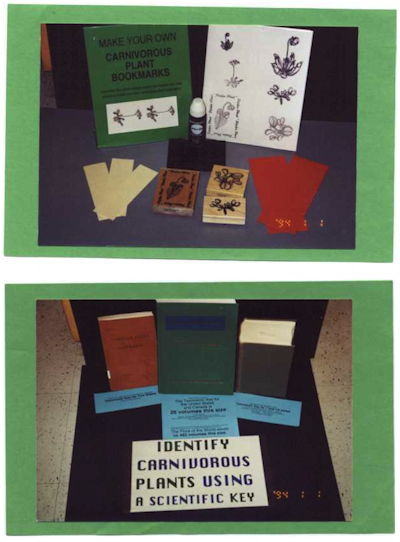The Weird, Wild, Wacky and Wonderful World of Carnivorous Plants is a six Saturday, two hour per day course for seven through nine year old students. A different carnivorous plant group is studied on each of the first five days. Parents are invited the sixth class day to experience what their children have learned.
About eight activities are completed each class day. The class day begins with basic organizational tasks. As students arrive, they are encouraged to hang up their coats, to color and put on their name tags, and to mentally prepare themselves for the class.
The parent volunteers of the day are introduced to the students at the beginning of class. On each day, two parents volunteer to assist in the class.The parent volunteers hand out and collect the materials for each activity. The parent volunteers also keep the students on task and assist them with the more challenging projects.
The first formal activity of each class is the reading of a Blood Thirsty Plant book. Published in 1996 by the Gareth Stevens Publishing Company, this series consists of six 24 page books; five on the topic of carnivorous flowering plants and one on the topic of carnivorous fungi. The students sit comfortably on a large quilt on the floor while I read them the book that corresponds to the carnivorous plant group of the day. During the reading, I incorporate facts on our local carnivorous plants and encourage the students to ask questions. After the reading, students meet live carnivorous plants. Parent volunteers whisk away the quilt, and set out the examples of the carnivorous plant of the day. Students are encouraged to look, touch, and smell the live plants. Do they see insects that have been caught? Have they felt the sticky goo? Do the leaves' nectar or any flowers present have any scent? Students are encouraged to voice their comments and to ask questions.
The third official activity is the placement of the plant of the day in a bell jar with fruit flies. Fruit flies are obtained by mail from one of several science supply companies. The fruit flies are placed in a small clear glass jar topped with a soft foam stopper and long string to pull to release the flies. The bell jar has a small hole in the top through which the fly bottle release cord is threaded. The plant and flies are placed under the bell jar. Students watch intently as the flies buzz around inside the bell jar, some landing on the carnivorous plant. While sundews and butterworts most visibly detain the fruit flies, interesting plant and fly interactions can also be seen with pitcher plants and Venus flytraps.
The hunting techniques of the aquatic bladderworts and waterwheels cannot be observed using the bell jar method. Instead, they are observed in water filled with swimming protozoa under a projecting video microscope.
The fourth activity is the completion of a workbook page that summarizes what the students have learned. This is conducted as a group activity; students raise their hands to answer the questions printed in their workbook. These questions reinforce the information learned from their observations, from what I have told them about the local species, and from their reading. At this point, approximately an hour has passed. Students now take a short break.
Parent volunteers chaperone the students to the restrooms and drinking fountain. During the final hour of class, the students work on two or three craft activities that build on the knowledge gained during the first hour. The craft activities vary each week and are inspired by the plant group of the day.
Week 1: Sundews
For the week one sundew unit, there are two creative expression activities. The first activity is the planting of Cape sundew (Drosera capensis) seeds in plastic terrariums. Students roll up their sleeves to moisten potting soil with distilled water. Students fill their eight ounce cups with the potting soil and sprinkle on the dust-like seed. Cape sundew seeds are used because they are readily available, they germinate within 14 days, and a high percentage of the seed germinates. The seedlIngs are grown in the classroom; students are able to observe the weekly progress of their plantings.
The next activity of the sundew unit is the construction of a potted sundew plant. A Styrofoam cup serves as the pot. A sheet of green tissue paper, crumpled, serves as the soil. The sundew plant is constructed from colored pipe cleaners and is stuck into the tissue, paper and Styrofoam cup pot. Sundew flowers and insect prey are also constructed from the pipe cleaners.
Week 2: Butterworts
For the week two butterwort unit there are three creative expression activities. The first activity of the butterwort unit is the propagation of butterwort plants by leaf cuttings and divisions. Terrarium cups and soil are again prepared. Students pull apart large, overgrown butterwort plants and repot single leaves and individual rosettes. The cuttings are allowed to grow in the classroom. By the end of the six week class, the butterwort leaves are sprouting new baby plants.
The next activity of the butterwort unit is the creation of an origami butterfly. I use a very simple butterfly pattern and rely heavily on my parent volunteers to assure the accuracy of the folds. Students write their names on a wing of their completed butterflies. The butterflies are collected and stored for use during week three.
The final activity of the butterwort unit is the creation of butterwort bread. Dyed green bread is required for this activity. Oval bread slices represent butterwort “leaves”. Green butter will represent the “goo” found on the top of the butterwort leaf. The students make the butter in class.
To make green butter, mix together whipping cream, a little salt and green food color. Have small wide-mouth plastic bottles ready, one for each student. Place about a quarter cup of the mixture into each wide-mouth plastic bottle. Each student shakes his or her green cream concoction to make the butterwort butter. The green butter is spread on a slice of green bread to emulate the shape and sticky surface of the butterwort leaf.
Week 3: Venus flytraps
There are two creative expression activities in the Venus flytrap unit. For the first activity, students make Venus flytrap puppets out of paper plates. First, a paper plate is folded in half. Next holes for three fingers and the thumb are cut in the plate. The students' fingers protruding through these holes represent the Venus flytraps' trigger hairs. Narrow triangles are cut out of the outer edge of the plate to create the guard hairs. The plate is then colored venus flytrap colors of green and red. The Venus fly trap puppet is used to “eat” the origami butterflies created during week two.
The next activity for the Venus flytrap unit is the construction of a Venus flytrap flip book.The Venus flytrap flip book was developed by Michael Szesze and is described in his Activity Book for Carnivorous Plants (see references at end although they may no longer be available).
Week 4: Pitcher plants
There are two creative expression activities for the pitcher plant unit. I was fortunate to find three different commercially-made jigsaw puzzles for children of realistic scenes of wetlands or tropical forests that include images of pitcher plants. I made up questions or riddles concerning the pitcher plant habitat and the other plants in the puzzle. The students answer the riddles after they have completed assembling a puzzle. The students complete one to all three of the puzzles, as time allows. Unfortunately, all three of these jigsaw puzzles are now out-of-print and unavailable. The next activity of the pitcher plant unit is the molding of pitcher plants in green clay. The green clay is an excellent media to explore the three-dimensional form of pitcher plants.
Week 5: Bladderworts
For the week five bladderwort unit, there are two main creative expression activities. First the students and I physically act out the action of the bladderwort trap in a type of dance. To do this activity, I have the students all stand in a circle and join hands. I then break the circle, and reconnect it two students in. Two students are thus connected to the circle, but are not a part of it. These two students represent the trigger hairs. The large circle of students represents the bladder proper. A volunteer parent serves as the “prey”. We flatten our circle of students to represent the flattened, ready position of the bladderwort trap. When the parent “prey” comes in contact with the student “trigger hairs”, the student circle opens and expands to engulf the prey. Then the circle slowly flattens again as the imaginary water is expelled and the prey is digested.
The next activity of the bladderwort unit is the creation of water color paintings of carnivorous plants. A short biography of the painter Georgia O'Keefe, who grew up a short distance away from our small town in Wisconsin, is read to the students while they paint.
Anytime left at the end of the creative expression activities is given to work on the creative expression workbook pages. On these nearly blank pages, students create their own stories, acrostic poems and pictures.
Week 6: Parents day
For parents' day in week six, parents and children have the opportunity to share many of the most fun activities of the previous five weeks. The activities that are repeated for parents' day are:
- seeing live examples of all of the carnivorous plant groups
- seeing fruit flies being caught by a carnivorous plant under a bell jar
- seeing aquatic bladderworts and Protozoa using a projecting video microscope
- making butterwort bread
- assembling jigsaw puzzles and answering habitat riddles.
In addition, there are a number of new activities on parents' day:
- parents and students are led on a tour of the University greenhouse
- we eat treats; I make sugar cookies cut in the shape of sundews; I also provide “nectar-like” juice drinks
- students try out a shortened version of a taxonomic key and key out carnivorous plants from a small selection
- students make a carnivorous plant book mark
- students draw a carnivorous plant in fabric crayons to iron onto a t-shirt.
The students take home their crafts, their workbooks and their sundew and butterwort plants. The student workbook include lists of carnivorous plant books to read, local sources of seed and plants, the locations of public gardens that house carnivorous plants as well as new activities to try so that they can continue their learning.
Carnivorous plants incite interest and awe in young people. Carnivorous plants provide natural conduits to deeper discussions of conservation biology, species diversity and land stewardship. Through this class, I hope to inspire young people to protect the natural world.
This article is based on a presentation at the ICPS 2004 conference in Lyon, France, and the related proceedings published in Acta Botanica Gallica.
Golembiewski, T. A. (2005) The weird, wild, wacky and wonderful world of carnivorous plants: an enrichment course for children ages seven through nine. Acta Botanica Gallica 152(2):251-255.
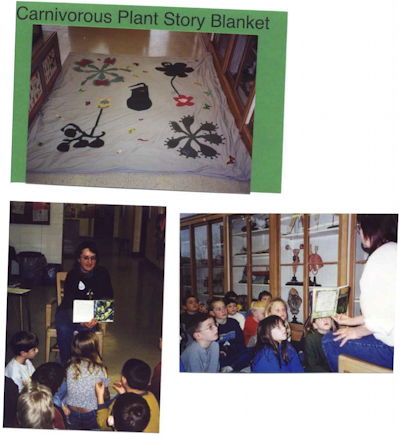
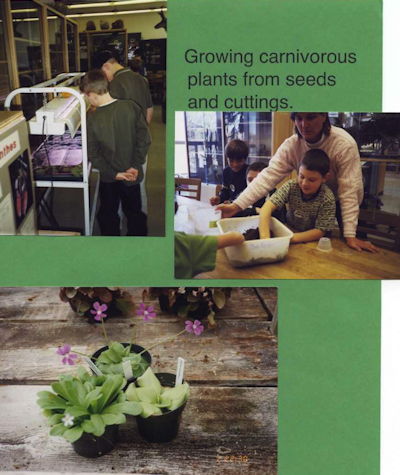
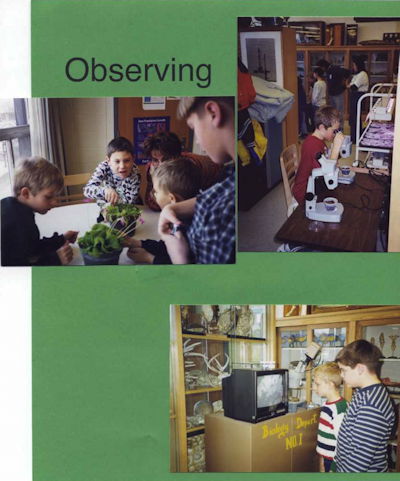
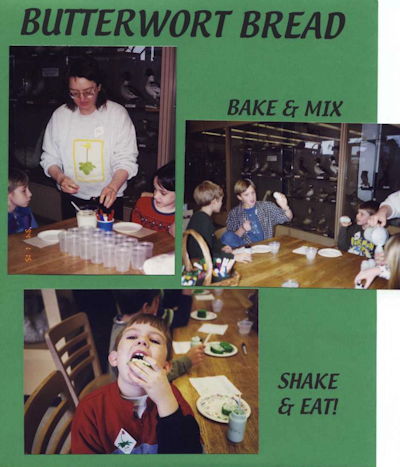
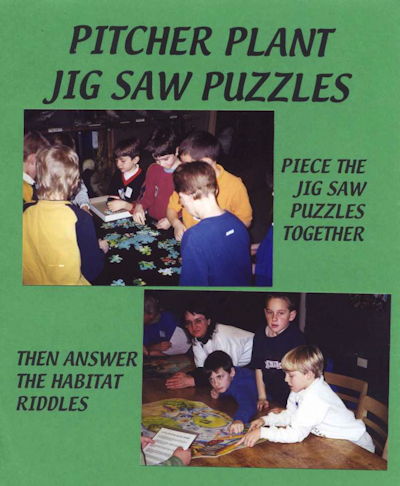
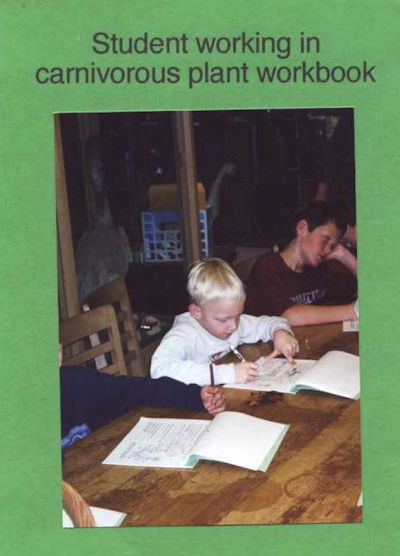
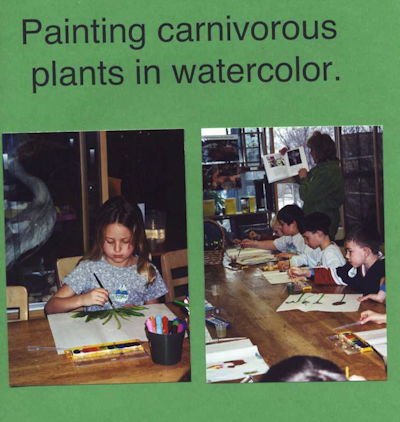
Documents
 |
The Weird, Wild, Wacky and Wonderful World of Carnivorous Plants: an enrichment course for children ages seven through nine Four page handout version of this web page in PDF format for printing. |
|
 |
 |
Course Syllabus Single page with need-to-know information for students and parents. |
 |
 |
Course Workbook Each student gets a workbook for answering questions, drawing pictures, and writing stories about carnivorous plants. |
 |
Pipe cleaner Sundews Plant pipe cleaner sundews into a foam cup. |
|
 |
Venus Flytrap Puppet Construction Make Venus flytrap traps from a paper plate. Templates may be enlarged or reduced on a copier to fit your paper plates. Based on a project in Literature in the Garden, http://www.jmgkids.us/ |
|
 |
Butterwort Bread Bread and butter are used to demonstrate the butterwort leaf. |
|
 |
Bladderwort Dance Children and parents can act out the workings of a bladderwort trap. Bladderwort Dance was first published in Environmental Concern. |
|
References
Golembiewski, T. A. (2005) The weird, wild, wacky and wonderful world of carnivorous plants: an enrichment course for children ages seven through nine. Acta Botanica Gallica 152(2):251-255.
Literature in the Garden. (2005) Junior Master Gardener Program, Texas A&M University System Cooperative Extension. http://www.jmgkids.us/
Szesze, M. (1997) An Activity Book for Carnivorous Plants. 255 pages. Self Published. http://www.carnivorousplantnursery.com/
Gentle, V. (1996) Bloodthirsty Plant Series. Gareth Stevens Publishing, 1555 North River Center Drive, Suite 201; Milwaukee, WI 53212, USA
Bladderworts: Trapdoors to Oblivion (ISBN 0-8368-1654-4)
Butterworts: Greasy Cups of Death (ISBN: 0-8368-1655-2)
Pitcher Plants: Slippery Pits of No Escape (ISBN: 0-8368-1657-9)
Sundews: A Sweet and Sticky Death (ISBN: 0-8368-1658-7)
Venus Fly Traps and Waterwheels: Spring Traps of the Plant World (ISBN: 0-8368-1659-5)
Carnivorous Mushrooms: Lassoing Their Prey? (ISBN: 0-8368-1656-0)
Teresa A. Golembiewski
Department of Biological Sciences
University of Wisconsin-Whitewater
320 Upham Hall
Whitewater, WI 53190
USA
Parents Day displays
